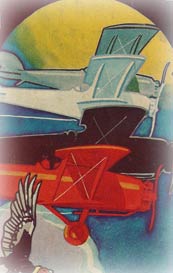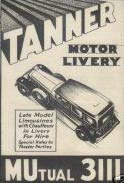|
Registration Number 8420
A TRAGEDY OF THE FIRST ORDER
This aircraft is a Stinson SM-1F Detroiter, manufacturer’s
serial number 504. It was manufactured in March 1929 by Stinson
Aircraft Corporation, Northville, MI. It came from the factory
with a 300 HP Wright J-6 (R-975A) engine, S/N 10257. The airplane
weighed 4,300 pounds (six-place).
It was sold 3/28/29 for $12,500 to Tanner Motor Livery of
Los Angeles, CA (C.C. Tanner, President; Charles Towns, Chief
Pilot and delivery pilot). Advertisement, right, from a period
magazine.
It comes to Tucson on 4/7/1929 piloted by Charles V. Towns
carrying two unidentified passengers. They were westbound
from Detroit, MI to Los Angeles, CA. This was probably the
ferry flight from the factory of this brand new airplane.
Less than a year later, on January 2, 1930 this airplane
collided with another Stinson Detroiter (registration number
not recorded) at Rocky Point, CA. The planes collided in
the air while taking motion pictures. Apparently sun glare
blinded the pilots. The pilot of 8420, Hallock Roose (transport
license #402), the pilot of the other Stinson, Walter Ross
Cook, Santa
Monica, CA, and all passengers were
killed.
Passengers in both aircraft were listed in the NASM record,
and included: Max Gold, Conrad Wells (cinematographer, 1927-30),
Ben Frankel, Kenneth Hawks (a director; married Mary Astor
in 1928; was supervising the shot at time of crash; he was
32 years old), George Eastman (cinematographer, see*, left),
Otto Jordon, Hank Johannes and Tom Harris. The official
report states tersely, “…collision in air.
Lost in ocean off Pt. Vicente.” The registration was
cancelled 2/14/30.
---o0o---
From Wynn's book cited at bottom left, this passage captures
that horrific event (pp.94-95):
"The scene plan called for three airplanes,
one with a parachute jumper and two with cameras, to
take off from Clover Field and rendezvous three miles
at sea of Point San Vicente. At that point the camera
planes would spread apart while the plane with the
jumper flew between them. When the jumper bailed out,
the cameras would record the jump and descent from
different angles. A speed boat cruised in the sea below,
with another camera aboard to record the jump from
sea level, and to pick up the jumper after he descended
into the water.
"The three airplanes took off just before 4:00PM
as the winter sun was approaching the horizon, In the
lead was a Lockheed high-wing monoplane painted bright
orange to contrast with the blue sky and sea in order
to show up clearly on the black and white film. In
addition to pilot Roscoe Turner, the Lockheed carried
Jacob Tribdwasser, the parachute jumper, Fred White,
a representative from the parachute company and Fred
Osborne. The other two planes were identical
Stinson “Detroiters,” leased from Tanner
Air Tours, and flown by Ross Cooke and Halleck Rouse. Kenneth
Hawks, who was acting as director and was brother of
Howard Hawks and husband of actress Mary Astor, flew
in one plane. Max Gold, the assistant director
on the film, rode in the other Stinson. Cameraman
George Eastman, assistant cameraman Ben Frankel, and
prop man Tom Harris, rode in one of the Stinsons, while
the other cameraman, Conrad Wells, his assistant Otto
Jordan, and prop man Harry Johannes rode in the other
Tanner airplane. Newspaper accounts don’t
say which group rode with which pilot, but each camera
planed carried five men, and the doors were removed
to give the camera men more freedom of action.
“When they reached the rendezvous point, Turner,
in the faster airplane, was ahead while the two camera
planes, cruising one above the other, headed directly
into the brilliant sun….
“Perhaps the sun affected the vision of one or both of the pilots. The
higher airplane banked slightly to the right, and the one below suddenly swerved
upward and to the left. They were about 3,000 feet high when their wing
tips touched, drew apart and then touched again. When the second contact
was made, one plane pivoted on its wing tip and collided with the other, almost
nose to nose. A burst of flame suddenly consumed both Stinsons as two
twisting bodies fell or jumped from the fireball. Then
men were already dead as the two burning airplanes
struck the water and sank in forty fathoms of the sea.” |
UPLOADED: 07/28/05 REVISED: 04/02/06
|


